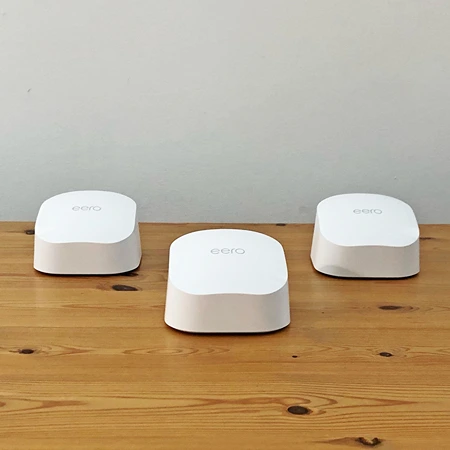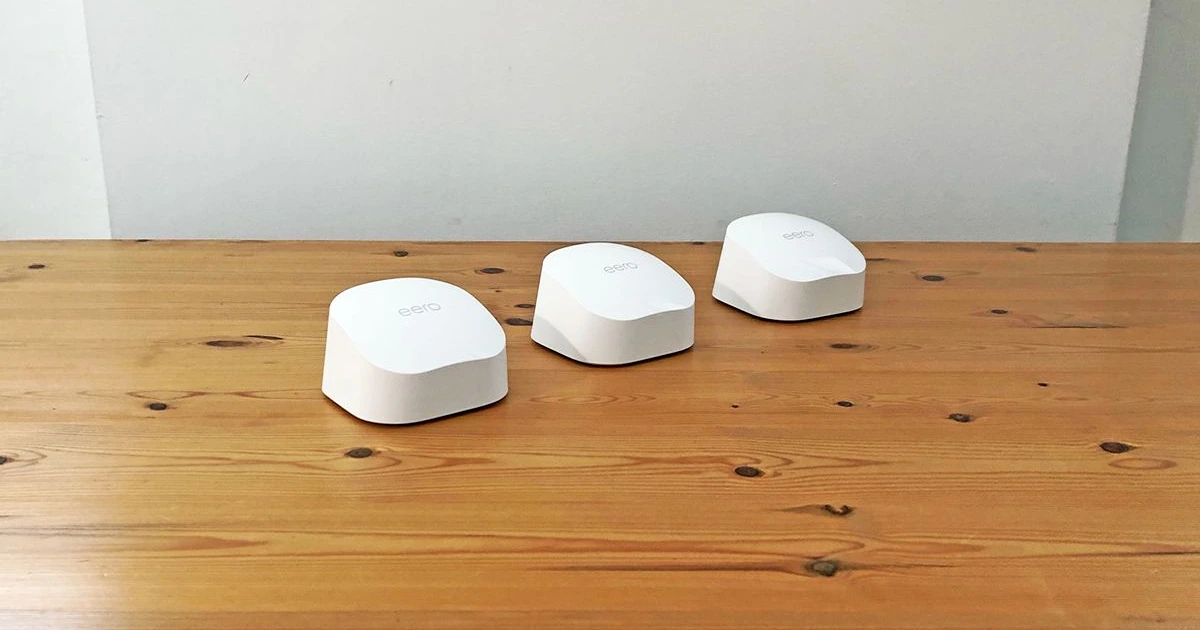
A fast, reliable mesh Wi-Fi system with support for Wi-Fi 6, easy app-based setup, and built-in smart home hub features for seamless connectivity.
Buy on AmazonThe Eero 6 is Amazon’s latest whole-home mesh Wi-Fi system, designed to eliminate dead zones and keep every corner of your house connected. Eero made a name for itself early on by offering an elegant solution to a common problem: spotty Wi-Fi. Its original mesh system was simple to set up, provided seamless coverage using a single network name, and looked good doing it.
Since then, plenty of competitors have entered the mesh Wi-Fi space — but Eero’s TrueMesh technology, user-friendly app, and competitive pricing helped it stay ahead of the curve.
One key feature that was missing from earlier models, though, was Wi-Fi 6. With the Eero 6, that’s finally been addressed — delivering faster speeds, better device handling, and more reliable connections. Another welcome upgrade: it now includes a built-in Zigbee hub, so you can control compatible smart home devices via Alexa without needing a separate hub.
In this review, I put the Eero 6 to the test to see how well it delivers on speed, coverage, and convenience.
Design & Build
The Eero 6 system stands out from typical networking gear with its minimalist design. Instead of bulky, angular units with visible antennae, each device is a compact, rounded cuboid finished in glossy white plastic. Measuring just 99.4 x 97 x 61.4mm, they take up very little space and resemble smart plugs more than traditional routers.
Like most mesh Wi-Fi systems, the Eero 6 includes a main router unit and one or more satellite units, or extenders. The only visible difference between them is that the router includes two Ethernet ports, while the extenders do not. The router connects directly to your modem and can function as a standalone unit, while the extenders are placed throughout the home to expand coverage.
A standard three-pack setup, which includes one router and two extenders, is rated to cover up to 460 square meters (approximately 4,950 square feet). A single unit covers around 140 square meters (1,500 square feet), which is consistent with the original Eero system.
For homes that require additional wired connections, more router units can be added instead of extenders. This offers extra Ethernet ports and extends the mesh network simultaneously. However, if multiple wired connections are needed across the home, users may want to consider adding an Ethernet switch or opting for a mesh system with more built-in ports.
For comparisons and alternatives, see our roundups of the best mesh Wi-Fi systems and top-rated routers.
Setup & Features
The Eero 6 follows the same streamlined setup process as the original Eero, making it especially user-friendly for those new to home networking. Setup begins with downloading the Eero app, available on both iOS and Android, which guides users step-by-step through installation with clear instructions and helpful animations.
Each device is paired via Bluetooth, although manual entry of the serial number is also available as a fallback. Once the main router is connected and running, users can name the network, set both a network and admin password, and assign the router to a specific room. The same process is repeated for satellite units, allowing for easy identification of device locations throughout the home.
The app also provides a real-time overview of connected devices, showing which access point and radio frequency each one is using. Devices can be assigned to profiles to enable content filtering, internet pauses, or scheduled access — useful for managing screen time or limiting usage.
Creating a guest network is quick and straightforward, and users can easily modify network names, passwords, and settings through the app. A built-in dashboard displays bandwidth usage per device, helping to identify which ones are consuming the most data.
Parental controls, ad blocking, and other advanced features are bundled under a single subscription called Eero Plus. This replaces the previous Eero Secure and Secure Plus plans and now includes added tools such as a password manager (1Password), VPN access (Encrypt.me), and anti-malware software (Malwarebytes).
Additionally, the Eero 6 includes a built-in Zigbee smart home hub, allowing users to control compatible Alexa devices directly through the Eero app. Experimental features can also be explored in the Eero Labs section, offering early access to new capabilities.
Overall, the app-focused setup and management experience is intuitive, accessible, and packed with useful features for both casual users and more advanced home network managers.
Performance
This is where the Eero 6 distinguishes itself from previous Eero models that only support Wi-Fi 5. With growing support for Wi-Fi 6 in modern smartphones, laptops, and smart home devices, the upgrade offers clear performance benefits for users with compatible hardware.
Speed tests conducted on both Wi-Fi 5 and Wi-Fi 6 devices show noticeable improvements, especially when positioned near one of the Eero 6 units. While direct comparisons to a standalone router like the Virgin Media Super Hub 3 (used in modem mode for these tests) are not entirely equivalent — given that the Eero system uses multiple hubs — the results highlight the advantages of mesh networking in reducing signal drop-off and extending coverage throughout the home.
Devices with Wi-Fi 6 antennas consistently delivered higher speeds and more reliable performance, particularly on the 5GHz band. However, as expected with all mesh systems, signal strength and speed may vary depending on placement, building materials, and the band used. For example, the 2.4GHz band tends to provide better range through walls but at lower speeds, while 5GHz offers faster speeds over shorter distances.
The Eero 6 system dynamically shifts devices between frequency bands based on signal strength and location, helping to maintain a stable connection as users move through the home. However, handoff between access points can occasionally lag, especially when transitioning between rooms with separate Eero units. In some cases, devices may temporarily remain connected to a more distant access point before switching over to a closer one.
This switchover typically resolves on its own within a minute, though manual reconnection (toggling Wi-Fi off and back on) can expedite the transition. Overall, the Eero 6 performs well in adapting to device needs and environmental conditions, offering a noticeable upgrade in coverage and speed over earlier models and traditional routers.
Final Verdict
The Eero 6 delivers fast, reliable Wi-Fi speeds, strong whole-home coverage, and an intuitive setup process, all at a competitive price point. It’s a practical solution for users looking to eliminate dead zones without the complexity of manually managing extenders or multiple network names.
Optional features like Eero Plus add value for those seeking built-in security tools and parental controls, with minimal configuration required. While more affordable standalone Wi-Fi 6 routers exist — such as the Honor Router 3 — they typically lack the multi-point coverage needed for larger homes.
That said, the absence of Ethernet ports on the extenders may be a limitation for users with wired connectivity needs. In such cases, alternatives like the Linksys Atlas 6 may be a better fit. Overall, the Eero 6 strikes an excellent balance between simplicity, performance, and coverage for most households.
